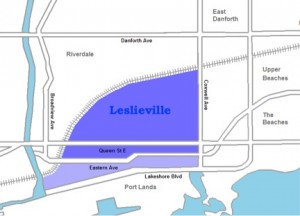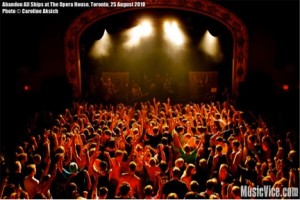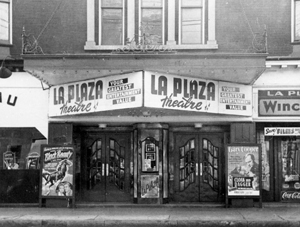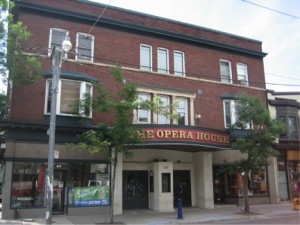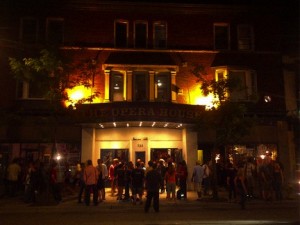The Opera House Toronto – Site Analysis
‘The Opera House’
Site Analysis Assignment
By: Martine Pinelli
Due: December 05, 2013
For the Site Analysis assignment, I chose a location that had a close relationship to the city that I grew up around, as well as carried on a long history and relationship with music. I wanted to make sure that it hosted a variety of different music styles and appealed to an eclectic assortment of audiences in order to make sure that the data collected through interviews and other sources in terms of experiences shared within the venue were as diverse as the location in itself.
This brings me to the identity of the location itself. For this assignment I have chosen the Opera House, which is location at 735 Queen street East, Toronto, Ontario, in the heart of Leslieville. Leslieville is a smaller area located just outside the Toronto Beaches surrounded by the Canadian National railway tracks in the South part of the city (Wikipedia).
(Photo credit: Wikipedia)
To formulate a distinct description of the Opera House was problematic in itself, because of the way that the venue still caters to a variety of different types of live entertainment. With everything from live bands and music performers, to club events and company parties with live DJ’s, to dancers and comedians, the Opera House is home to a number of different sources of entertainment for a wide range of audience members (Athena).
The Opera House is licensed to hold a total of 850 people within its structure, 580 on the main floor as well as another 270 on the balconies, creating both a more personal as well as a more sophisticated atmosphere accommodating the varieties of audience members, even by offering wheel chair ramps to those with disabilities (www.theoperahousetoronto.com). As well as accommodating to “pop-up shops” by artists and temporary vendors selling performance merchandise and other goods, The venue does not have any vending of its own other than the bars located at each end of the main floor, allowing for a steady flow of people throughout (Athena). The oversized stage allows for performances to be visible from all viewing arrangements within the building, as well as the professional lights and light shows that take place, and exponential sound systems adding up to a grand total of around 520 amps of power used overall within the venue (www.theoperahousetoronto.com).
(Photo Credit: www.theoperahousetoronto.com)
The Opera House has partnerships with many different companies and organizations such as Live Nation, Ticketmaster, and even Molson Canadian where they sell tickets and VIP package experiences to the shows and performances that they host making them more accessible to a broader range of the public rather than tickets being sold solely through the venues personal website or through its in house box office (Athena).
All of these attributes come together to create one of Toronto’s most historically rich and modern day supplier of live music and entertainment with recognition from such magazines as ‘Exclaim!’, newspapers such as ‘The Globe and Mail’, as well as being exhibited on websites such as ‘umusic.ca’. The Opera House is definitely a core element to the way that Toronto experiences music in both the past and present times (Paul).
Leslieville is a large part of Toronto’s history. It was established in the 1850’s around the Toronto Nurseries that the area is known for which were grown by George Leslie and his sons (www.theoperahousetoronto.com). The Lelieville area was known for its tall, free standing maple tree that grew proudly at the corner of Landing Street and Memory Lane, which is said to be the exact tree that inspired poet and songwriter Alexander Muir to write his nationally celebrated song, “The Maple Leaf Forever”, as he was walking by this tree in the midst of autumn and a single maple leaf fell upon his jacket sleeve (Toronto Standard). Unfortunately, that same Maple tree, fell earlier this year during a thunderstorm, where it was struck down by lightening (Toronto Standard).
The area thrived off of the popularity of the nurseries and therefore named itself after the Leslie family and its accomplishments. Shortly thereafter, Leslieville’s community thrived on the surrounding brick making factories and markets and most of its citizens were market gardeners and brick makers, which led to a steady flow of disposable income and leisure time throughout the community. This is when the ideas of entertainment and a stronger sense of a nightlife atmosphere started to arrive in the scene of Toronto, and Leslieville thought it would be a great addition to their thriving community if they too could incorporate theatre and other elements into their fast changing street style (Toronto Standard).
As Leslieville continues to change, it would not be a surprise if one day in the near future for the venue of the Opera House to relocate, or disappear altogether. This of course would have to only take place if the thrill or spectacle of live music were to once again take a plummet in interest from the public as it did in the past. The reason I say this is because of the way that we have seen the shift in Leslieville from a community of hard working, theatre-enjoying citizens, to a more upscale, wine and cheese type community, in the sense that it has become a lot more conservative in outlets it now offers to its public, such as small bakeries, eateries, etc.
A short way down the road from the Opera House venue, a lively soca and reggae playing restaurant and bar called, “The Real Jerk”, stood proudly serenading the community of Leslieville. You could always find an interesting assortment of people eating West Indian foods and delicacies while listening to and dancing to their favourite upbeat tunes, you could always hear The Jerk from a mile away as the music both live and recorded could be heard for quite some distance. The Real Jerk was a Leslieville tradition and everyone in the area knew what was to be expected of the noise and sounds you could hear at all hours of the day and night, but as the area of Leslieville began to change, so did the residents and the complaints about The Jerk’s sound pollution complaints were filing in more regularly, until the day where it was closed down completely. There are rumors of an Irish pub to take the place of The Real Jerk we know that whatever goes in to that lot will definitely not hold the same power and tradition of years of jerk chicken once did, and will now be conforming to the new vision of Leslieville (Toronto Standard).
The Vaudeville theatre was built at the location of 735 Queen street East, and was used to host variety shows and an assortment of different musical artists and performers which entertained the Leslieville and other surrounding communities right up until the early 1900’s when a doldrums took place towards live entertainment with the emergence of big Hollywood films, and movie theatres began to pop up all over the cityscape.
It was time for Leslieville to catch up with the times and realize the doldrums that were taking place in Toronto’s live entertainment theatres, and it was decided that the Vaudeville theatre on Queen street East would now become Le Plaza Theatre which hosted numerous Hollywood films on its large projectors and screens (which can still be found on the rear balconies in the venue to this day). Le Plaza ran from about the 1930’s to the 1960’s, and then with the resurfacing of live entertainment and a focus on live music in the 1960’s and 1970’s, Le Plaza took the majority of its projection screens down, added an abundance of professional lighting and sound systems, and became the Opera House concert hall and live entertainment theatre that still currently stands tall a loud in the heart of Leslieville.
“Le Plaza Theatre”
(Photo Credit: www.theoperahousetoronto.com)
Keeping with the historical tradition of the Opera Houses original purpose of entertaining, the venue still hosts variety shows at the venue on certain occasions maintaining the historical theme of the original Vaudeville theatre, with a new modern, 21st century twist (www.theoperahousetoronto.com)
Other than the more physical changes that the Opera House has been through since its erection in the late 1800’s, the venue has definitely been a large benefactor to the way that Torontonians in the South-East end of the city enjoy and appreciate live entertainment and the value of the experiences shared within its architectural design (Athena). Not only has the Opera House become a monument to those who experience it regularly by attending its shows and other events in the present day, the building also represents the historical elements and music roots of the Leslieville community as a whole.
The experiences that become possible in this space are all due to the acoustic inviting architecture of the building, accompanied by the live entertainment being performed by bands, etc., emphasized by the professional sound quality speakers and other sound systems that send excess sonic waves through each square foot of the venue. Though the venue isn’t as large as other surrounding concert halls in the Toronto area such as the Ricoh Coliseum, it is actually the smaller size to the Opera House that works in favour of the atmospherically enhanced ways that audience members experience the sounds within this venue. The small structure of the venue quite surprisingly works in favour of bringing the audience members together physically, which then allows them to bond closer mentally and emotionally (Rob), as well over their same passion and desire for live music in a relation of sharing affect (Grossberg). The stages access to the main floor continues this sense of closeness to the audience members with even the band/performers as they may choose to interact with their fans and are able to do so using this arrangement (Paul).
As was mentioned in the historical background of the venue, the Opera House was originally designed as a source of live entertainment for the middle-class audience with leisure time and disposable income that were interested in the arts and theatre. Compared to the audiences of today, the Opera House hasn’t changed too much in the sense that it still attracts those with appreciation for the arts and live performances, but has changed in the fact that the audience types range much broader than before. The Opera House now hosts all ages events as well as 19+ events, allowing for a variety of different age groups, scenes and subcultures (Hebdige) to come and enjoy the experience together. This being said, it is still a middle-class group that the Opera House appeals to in terms of ticket prices being not too low, but not unreasonably high, as well as the type of performances being more mainstream and underground music rather than higher art forms such as ballets, etc. Therefore it is safe to say that the Opera House appeals to middle-class individuals with disposable income and leisure time with a passion for experiencing live entertainment.
It is obvious that the Opera House venue is that of a high fidelity environment, in terms of it being entirely individual sounding from anything else in its parameters. This also distinguishes the venue as a soundmark (Schafer) of the Leslieville area, being unique and predominantly audible during hours of business when performances are taking place. Though this may be true, the venue becomes eerily docile during hours outside of performance times and is more something to be seen rather than heard. When the site is not taking place in holding hundreds of audience members and echoing sounds of music and applause throughout the streets of Leslieville, it is still and silent against the hustle and bustle of the sounds of the streetcars and car horns throughout the city streets.
The Opera House has made good use of an idea raised by Small that was talked about in class on the ideas as music being more than just music and sound in itself. In fact, Small states that music can be made in to much more than just something we listen to, but also as, “works, performances, experience, technology, and commodity” (Small). The Opera House takes all of these into effect with the way that it conducts business through the selling of tickets to events as well as selling beverages and even allowing access to vendors who wish to sell band and other performer merchandise within the venue, also adding ideas of the commodification of music (Straw). The performances element is apparent in the ways that live entertainers are set before the audience members in order for the spectacle of music and the overall performance to take place in a way that fulfills the audiences needs and wants in terms of experiencing the music in a live setting rather than listening through their headphones at home (Rob). The technological elements come from the hundreds of dollars spent each month putting on spectacular lights shows and having the top-of-the-line sound systems resonating throughout the walls of the site.
Labelle talks about our relations to music in a way that audience members say is a primary reason they view and attend live music performances at venues such as the Opera House. The Opera House, like other concert hall venues, allow us to experience the music from its roots of the performers and sometimes songwriters themselves, acting out scenarios and expressing their own interpretations of their music on stage for all to see (Paul). It is with the visual performances combined with the sounds of the music we are so familiar with creates the all around new relations and bonds we create to the music and the performers themselves as well as those around us who are sharing the experience.
“The Opera house has a feel that not many other venues have. While many may not know the history, or exact events that have taken place, it is almost as though the space speaks for itself” (Rob). Many of the interviews I conducted resulted in audience members, as well as staff members making sure it was very clear that the Opera House has an effect on its audience members that no other venue can compare to. The interior has stayed the same throughout the years other than some minor old age repairs and refinishes, and therefore all of its history still “lies within its walls” (Athena).
The venue evokes a sense of musicking (Small) to where the audience not only listens to the music, but also takes part in the energy that the music produces (Paul). The flow of energy captivates the audience from everyone on the floor to the very top seats on the balconies; you can feel the rush resonating from every corner of the building when a concert is taking place (Rob). We can see evidence of this through the many images posted online in blogs, on websites, and in newspapers of how the crowd moves together and reacts together in an almost simultaneous and premeditated movement. Though every individual in the crowd has a specific way of moving to the beat of the music, the experience allows them to subconsciously combine as one embodiment, cause a chain reaction and mutual adjustment from all parties (Athena). “It is almost infectious, the ways that the energy, emotions, and passion surge through the crowd” (Rob).
Auditory scaffolding is another component of the ways that these influences allow us to relate to the tasks and events we take part in, in our everyday lives, to the experience that we share while attending musical performances such as these, and how we use these new found relations to establish who we are and how we project ourselves to those around us, embodying these personas reflected from or within the music (Labelle). In the case of the Opera House, the experience that is left within the audience when taking part in viewing a performance is the feeling of a sense of community (Cohen), that each person included in the audience feels as though no matter what race or gender, that they belong to the way that all of these personalities collide within this experience itself (Paul).
(Photo credit: www.theoperahousetoronto.com)
 Opera House during the daytime (non-business hours)
Opera House during the daytime (non-business hours)
VS.
(Photo credit: www.theoperahousetoronto.com)
Opera House during hours of operation
Works Cited
Athena. Personal interview. 18 Nov. 2013.
Cohen, Sara. “Sounding Out The City: Music and the Sensuous Production of Place.” The Place of Music,
Leyshon, A., Matless, D., and Revill, G. (eds), New York: The Guilford Press, 1998. 269-290.
Forman, Murray. “Represent: Race, Space and Place in Rap Music.” Popular Music Vol. 19 (2000), No. 1, 65-
90.
Hebdige, Dick. “Signifying Practice”. Subculture: The Meaning of Style. Routledge: London, 1979.
LaBelle, B. “Pump up the Bass – Rhythm, Cars, and Auditory Scaffolding”. Senses & Society, Vol 3: (2008),
Issue 2, 187-204.
“Leslieville.” Wikipedia. Wikimedia Foundation, 28 Nov. 2013. Web. 2 Dec. 2013.
<http://en.wikipedia.org/wiki/Leslieville>.
Paul. Personal interview. 20 Nov. 2013
“Returning to Leslieville | Toronto Standard.” Toronto Standard RSS10. N.p., n.d. Web. 2 Dec. 2013.
<http://www.torontostandard.com/the-sprawl/returning-to-leslieville>.
Rob. Personal interview. 18 Nov. 2013.
Schafer, R. Murray. The soundscape: our sonic environment and the tuning of the world. [New ed. Rochester,
Vt.: Destiny Books, 1994. Print.
Small, C. “Prelude”. Musicking. Wesleyan University Press: (1998). 1-18. Web. 26 Nov. 2013.
Straw, W. “Sizing Up Record Collections: Gender and Connoisseurship in Rock Culture”. 3-16.
“The Opera House | Toronto.” The Opera House | Toronto. N.p., n.d. Web. 2 Dec. 2013.
<http://www.theoperahousetoronto.com>.

